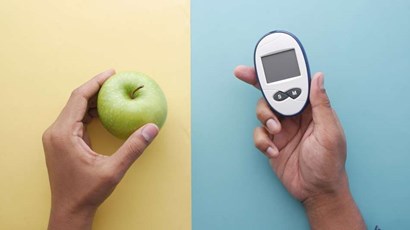Type 2 Diabetes Treatment
Although diabetes cannot be cured, it can be treated successfully. If a high blood sugar level is brought down to a normal level, your symptoms will ease and your risk of long-term complications will be much lower.
Managing type 2 diabetes
Keeping your blood sugar (glucose) well controlled is key to reducing your risk of long-term complications such as heart, kidney or eye problems.
Regardless of whether you need medication or which medication you are taking, diet and lifestyle play a key part in preventing long-term complications. You can find out more about how you can improve your diabetes control with diet from our separate leaflet called Type 2 Diabetes Diet.
The initial stages in type 2 diabetes treatment are usually to follow a healthy diet, lose weight if you are overweight, and do regular physical activity. If lifestyle advice does not control your blood glucose levels then medicines are used to help lower these levels. One medicine (usually metformin) is used first but two or even three medicines may be needed.
In addition to controlling your blood glucose, keeping raised blood pressure, cholesterol and other risk factors under control are also important. You can read more about controlling other risk factors in our separate leaflet called Type 2 Diabetes.
The rest of this leaflet is about medications to control blood glucose.
Medication to reduce the blood glucose level
Most of the type 2 diabetes medicines are given in tablet form. However, some people with type 2 diabetes need insulin injections to help control blood sugar (glucose) levels. Some people gain a great deal of benefit from insulin injections. Insulin injections can be used in combination with other medicines to further improve glucose control.
Medication is used in addition to, and not instead of, the above lifestyle measures.
Is one medication better than another for type 2 diabetes treatment?
According to international guidelines, patients should take metformin as their first-line type 2 diabetes treatment unless there is a medical reason that it should not be prescribed.
However, in recent years, many new medicines have been developed for type 2 diabetes treatment. It has now been shown that some of them offer benefits in addition to glucose-lowering. For instance, SGLT-2 inhibitors in particular may protect the heart and kidneys. Therefore, they may be offered in addition to metformin as first-line treatment for people with certain health conditions or risk factors. You can find out more about who might be offered them under the section below on SGLT-2 inhibitors.
For other people with type 2 diabetes, various factors should be taken into account when choosing a 'second-line' medication to add to metformin. You can find out more about the individual medicines later in this leaflet.
- If it is important to avoid low blood glucose (hypoglycaemia) - DPP-4 inhibitor, SGLT-2 inhibitor, pioglitazone or GLP-1 mimetic.
- For people with a history of (or at high risk of) heart attack, stroke, etc - SGLT-2 inhibitor or GLP-1 mimetic with proven heart benefit.
- For people with a history of heart failure or chronic kidney disease - SGLT-2 inhibitor or, if not suitable, GLP-1 mimetic.
- For people where weight loss or avoiding weight gain is important - SGLT-2 inhibitor or GLP-1 mimetic (or DPP-4 inhibitor if neither of these is suitable).
- In the UK, the National Institute for Health and Care Excellence (NICE) recommends that with some exceptions, GLP-1 mimetics should only be prescribed for people with a body mass index (BMI) over 35.
Precautions if you are unwell
Some medications commonly prescribed to people with diabetes can cause complications if you are otherwise unwell, particularly if you are dehydrated. These include:
- SGLT-2 inhibitors.
- ACE inhibitors (used to reduce blood pressure and protect the kidneys).
- Diuretics.
- Metformin.
- ARBs, which may be used as an alternative to ACE inhibitors.
- Non-steroidal anti-inflammatory drugs or NSAIDs, used for pain.
If you are taking any of these medicines and become unwell, particularly with diarrhoea and/or vomiting, contact your doctor or nurse. They may recommend that you stop taking some of your medication temporarily. Our leaflet on diabetes and illness gives more advice on what you should do if you are unwell.
Metformin as a type 2 diabetes treatment
Metformin is a biguanide medicine. It lowers blood glucose mainly by decreasing the amount of glucose that your liver releases into the bloodstream. It also increases the sensitivity of your body's cells to insulin. This means more glucose is taken into cells with the same amount of insulin in the bloodstream. Metformin has also been shown in studies to lower your risk of other complications of diabetes (such as heart attack and stroke).
Metformin is almost always the first tablet advised if your blood glucose level is not controlled by lifestyle measures alone. It is particularly useful if you are overweight, as it is less likely than some other glucose-lowering tablets to cause weight gain.
Another advantage of metformin is that it generally does not cause hypoglycaemia. This is a possible problem with some other glucose-lowering tablets such as sulfonylureas, but these medicines are less often prescribed in current practice. You can also take metformin in addition to other glucose-lowering tablets if one tablet does not control blood glucose well enough on its own.
Possible problems with metformin
When metformin is first started, some people feel sick (nausea) or have mildly runny stools (diarrhoea). These are less likely to occur if you start with a low dose and gradually build up to the usual dose over a few weeks. If these side-effects do occur, they tend to ease off in time.
Other side-effects are uncommon. See the leaflet that comes in the medicine packet for full details of cautions and possible side-effects.
SGLT-2 (sodium-glucose co-transporter-2) inhibitors - canagliflozin, dapagliflozin, ertugliflozin and empagliflozin
Canagliflozin, dapagliflozin, empagliflozin and ertugliflozin are sodium-glucose co-transporter-2 (SGLT-2) inhibitors. These increase the amount of glucose you pass out of your body in your urine and so reduce blood glucose levels. These medicines can be used on their own or with other medicines to help control blood glucose for people with type 2 diabetes.
Several extra benefits of the SGLT-2 inhibitors have been identified for people using these drugs. These include:
- Weight loss.
- Reduction in blood pressure.
- Slowing down of decline in kidney function.
- Reduction in the risk of heart failure.
- Reduction in the risk of having a further heart attack if you have already had one.
SGLT-2 inhibitors and heart disease or heart failure
People with type 2 diabetes are more likely to have a heart attack or stroke (cardiovascular disease or CVD) or heart failure than other people. Numerous studies have shown that SGLT-2 inhibitors reduce the risk of developing heart failure, and reduce the risk of complications for people who have it. Studies have also shown that some SGLT-2 inhibitors can reduce the risk of CVD.
When you are diagnosed with type 2 diabetes (and regularly at follow-up checks) your doctor should assess you to see if you:
- Have evidence of CVD or heart failure.
- Are at high risk of CVD or heart failure.
If you have CVD or heart failure, your doctor should offer you treatment with an SGLT-2 inhibitor, along with metformin, as first-line treatment. If you are at high risk of CVD or heart failure, they should discuss the pros and cons of adding an SGLT-2 inhibitor to metformin as your first-line treatment.
If any of the above risk factors apply to you:
- If you are not currently on glucose-lowering treatment, your doctor will usually recommend you start taking metformin first. As soon as you are settled on metformin (and don't have significant side-effects), they will add the SGLT-2 inhibitor.
- If you are already taking metformin, your doctor should add in an SGLT-2 inhibitor.
- If you are taking metformin and other treatment(s), your doctor may discuss with you replacing one of your other treatments with an SGLT-2 inhibitor.
- Your doctor should offer or consider adding an SGLT-2 inhibitor regardless of your blood glucose control, because of the added benefits for your heart and kidneys.
- You should be offered an SGLT-2 inhibitor as first-line treatment if you cannot take metformin.
SGLT-2 inhibitors and chronic kidney disease
People with type 2 diabetes are at higher risk of chronic kidney disease (CKD) than people without. Some of the SGLT-2 inhibitors have been found to slow down decline in kidney function significantly, protecting the kidneys.
For this reason, if you have type 2 diabetes and CKD, you may be offered type 2 diabetes treatment with an SGLT-2 inhibitor even if your blood glucose levels are well controlled. If you have CKD, these drugs may not work as effectively to bring your blood glucose levels down. However, they still protect your kidneys even if your blood glucose does not change.
If you have CKD, you should also be taking an ACE inhibitor or ARB - drugs developed to treat high blood pressure, but which can also protect your kidneys.
The current recommendations for SGLT-2 inhibitors in type 2 diabetes and CKD are:
- Your doctor may recommend an SGLT-2 inhibitor even if you do not have CKD, to protect you from developing it.
- If you have CKD and have high levels of albumin in your urine (an albumin creatinine ratio (ACR) of above 30 mg/mmol) your doctor should offer you treatment with an SGLT-2 inhibitor.
- If you have CKD and moderate levels of albumin in your urine (an ACR of 3-30 mg/mmol) your doctor should discuss the option of SGLT-2 inhibitor treatment.
Possible problems with SGLT-2 inhibitors
You may be more prone to thrush infection and possibly cystitis while taking an SGLT-2 inhibitor. You are also more prone to dehydration - for instance, if you have a tummy bug.
A rare but serious side-effect of SGLT-2 inhibitors is a condition called ketoacidosis. This can lead to dehydration, drowsiness and serious illness. See the leaflet that comes in the medicine packet for full details of cautions and possible side-effects.
The risk of ketoacidosis is higher if:
- You are generally unwell.
- You have had ketoacidosis in the past.
- You are following a very low-carbohydrate or ketogenic diet.
Your doctor may advise you not to take an SGLT-2 inhibitor while you are on a very low-carb or ketogenic diet. You should avoid starting one of these diets while you are on an SGLT-2 inhibitor without discussing it with your doctor or nurse.
DPP-4 (dipeptidyl peptidase-4) inhibitors - also known as incretin enhancers
This group includes alogliptin, linagliptin, saxagliptin, sitagliptin and vildagliptin. Dipeptidyl peptidase 4 (DPP-4) is a chemical (an enzyme) which breaks down hormones called incretins. Incretins are chemicals which are produced by the gut (intestine) in response to food. Incretins:
- Help keep you feeling full; and
- Enhance your body's production of insulin; and
- Reduce production of another hormone, glucagon, which raises your blood glucose.
These type 2 diabetes treatments reduce your blood glucose level by enhancing the effects of incretins as they prevent DPP-4 from working. One of these may be advised in addition to metformin or a sulfonylurea, or even to both of these if your HbA1c level is still high.
Possible health problems with DPP-4 inhibitors
Side-effects are uncommon and are usually mild. They may include feeling sick or having wind (flatulence). If you take vildagliptin then there is a slight risk of liver damage. Therefore, you should have a blood test to check on your liver function before starting it and then at regular intervals. See the leaflet that comes in the medicine packet for full details of cautions and possible side-effects.
GLP-1 (glucagon-like peptide-1) mimetics - exenatide, dulaglutide, liraglutide, lixisenatide and semaglutide
Exenatide, dulaglutide, lixisenatide, liraglutide and semaglutide are glucagon-like peptide-1 (GLP-1) mimetics which are type 2 diabetes treatments given as an injection. They work in a similar way to the action of the naturally occurring hormone glucagon-like peptide 1. These actions include:
- Stimulating insulin secretion in response to glucose; and
- Preventing glucagon release after meals (glucagon is a hormone which raises blood sugar); and
- Slowing down emptying of food from the stomach, to keep you feeling full. People receiving this treatment usually lose weight.
Some of the GLP-1 drugs have been shown to reduce the risk of further heart disease in people who have had a heart attack.
GLP-1 drugs can be used as an add-on treatment to improve glucose control when insulin treatment is not acceptable. There is a once-weekly treatment available. However, in the UK type 2 diabetes treatment is often limited to people who are significantly obese, with a body mass index over 35.
Editor's note
Dr Krishna Vakharia, 6th December 2023
NICE has recommended tirzepatide for treating type 2 diabetes alongside diet and exercise in adults. It has been shown to reduce blood glucose levels and body weight. This will only be advised if you meet certain requirements which your doctor will discuss with you. See below for further reading.
Possible problems with GLP-1 mimetics
Side-effects may include feeling sick and having headaches. Hypoglycaemia is rare unless you are taking other medications which make you prone to hypoglycaemia. See the leaflet that comes in the medicine packet for full details of cautions and possible side-effects.
Insulin as a type 2 diabetes treatment
Insulin injections lower blood glucose. Only some people with type 2 diabetes need insulin. It may be advised if your blood glucose level is not well controlled by tablets. The dose and type of insulin used varies from person to person. Sometimes insulin is used alone. However, sometimes it is used in addition to your tablets (such as metformin or a sulfonylurea). If you are advised to use insulin, your doctor or practice nurse will give detailed advice on how and when to use it.
Your doctor may recommend starting insulin if:
- Your blood glucose is not controlled with three tablet treatments; or
- If you cannot take metformin and your blood glucose is not controlled with two tablet treatments.
Possible problems with insulin
Some weight gain is a common side-effect. Weight gain may be less of a problem if you use insulin in combination with a glucose-lowering tablet such as metformin. Hypoglycaemia is a possible complication. See the leaflet that comes in the medicine packet for full details of cautions and possible side-effects.
Nateglinide and repaglinide as type 2 diabetes treatments
Nateglinide and repaglinide have a similar action to sulfonylureas. However, they are not commonly used. After taking a dose they quickly boost the insulin level but the effect of each dose does not last very long. Each dose is taken shortly before main meals (and a dose omitted if you miss a meal). One of these medicines may be an option if you have meals at irregular times.
Possible problems with nateglinide and repaglinide
As with sulfonylureas, possible side-effects include weight gain and hypoglycaemia. See the leaflet that comes in the medicine packet for full details of cautions and possible side-effects.
Pioglitazone as a type 2 diabetes treatment
Pioglitazone is a thiazolidinedione (sometimes called a glitazone). Pioglitazone lowers blood glucose by increasing the sensitivity of your body's cells to insulin (so more glucose is taken into cells for the same amount of insulin in the bloodstream). They are not usually used alone but are an option to take in addition to metformin or a sulfonylurea.
Possible problems with pioglitazone
You should not take these medicines if you have heart failure, as this can worsen. Pioglitazone may also slightly increase your risk of breaking a bone.
Some weight gain is a common side-effect, probably due to fluid retention. Other possible side-effects are uncommon. See the leaflet that comes in the medicine packet for full details of cautions and possible side-effects.
Sulfonylurea medicines as type 2 diabetes treatments
There are several types of sulfonylurea medicines. These include:
They work by increasing the amount of insulin that your pancreas makes. (If you have type 2 diabetes, you still make insulin in your pancreas. However, you do not make enough to keep your blood glucose level normal.)
If you are prescribed a sulfonylurea, usually a low dose is started. The dose can be increased if necessary every few weeks until there is good control of the blood glucose level. You can take a sulfonylurea in addition to other glucose-lowering tablets if one tablet does not control blood glucose well enough on its own.
Possible problems with sulfonylureas
Sulfonylurea medicines used to be widely prescribed for people whose blood sugar (glucose) was still too high when they were taking metformin. However, sulfonylureas have several problems not shared by other medications. For this reason, they are no longer recommended as the standard choice after metformin.
Common or important side-effects of sulfonylureas include:
- Low blood sugar (also known as hypoglycaemia or having 'hypos'). This can lead to weakness, blurred vision, confusion, poor co-ordination and collapse. In very severe cases, it can be fatal. Please read the separate leaflet called Hypoglycaemia (Low Blood Sugar) for more details.
- Weight gain.
- Feeling sick, mild diarrhoea and constipation.
See the leaflet that comes in the medicine packet for full details of cautions and possible side-effects.
Acarbose as a type 2 diabetes treatment
Acarbose works by delaying the absorption of carbohydrates (which are broken down into glucose) from the gut. Therefore, it can reduce the peaks of blood glucose which may occur after meals. It is an option if you are unable to use other tablets to keep your blood glucose level down. It can also be used in addition to other glucose-lowering tablets. It is not widely recommended in type 2 diabetes guidelines (largely because of side-effects) and is not often prescribed.
Possible problems with acarbose
Many people develop gut-related side-effects when taking acarbose, such as bloating, wind and diarrhoea. Therefore, it is not used very often.
Further reading and references
Management of diabetes; Scottish Intercollegiate Guidelines Network - SIGN (March 2010 - updated November 2017)
Type 2 diabetes in adults: management; NICE Guidance (December 2015 - last updated June 2022)
Type 2 Diabetes Know Your Risk; Diabetes UK
Information prescriptions - living well; Diabetes UK
Management of hyperglycaemia in type 2 diabetes; ADA/EASD update
Diabetes - type 2; NICE CKS, October 2022 (UK access only)
Pharmacologic Approaches to Glycemic Treatment: Standards of Medical Care in Diabetes; American Diabetes Association (ADA), 2021
Tirzepatide for treating type 2 diabetes; Technology appraisal guidance, October 2023



